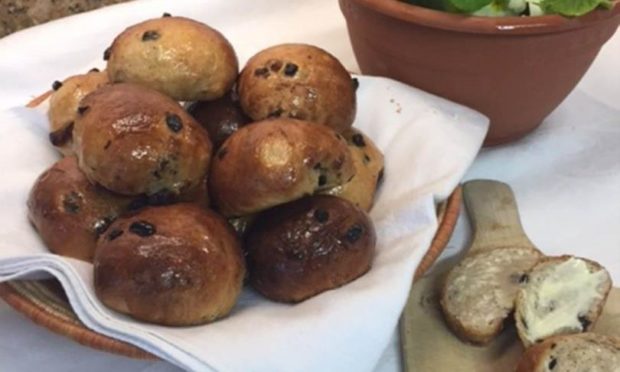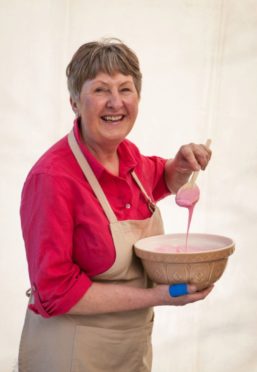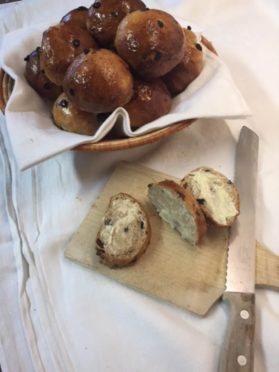Get in the mood for Easter with this recipe for hot cross buns from 2016 contestant Val Stones.
If you can cast your mind back to the Great British Bake Off back five years ago, when it was still presented by Mel and Sue and Mary Berry was still a judge, then you may remember a contestant from Doncaster called Val Stones.
Often referred to on the show as the “Cake Whisperer”, Val continued to bake long after being eliminated in the fifth week of the seventh series of the show and has since become the baking expert for Stannah stairlifts.
Ahead of Easter Weekend, Val has shared her recipe for homemade hot cross buns that you can try at home.
Val Stones’ hot cross buns
This recipe makes 12 buns, which can also be frozen for up to one month. If you ever have any leftover, they can be used to make a hot cross bun bread and butter pudding.
Ingredients
- 500g strong whole flour, plus extra for dusting
- 70g caster sugar
- 2 rounded tsp of mixed spice (8g)
- 1 level tsp of cinnamon (2g)
- ¼ tsp of freshly grated nutmeg
- 10g fine sea salt
- 12g dried yeast
- 50g of unsalted butter melted and cooled slightly
- 150ml of whole milk
- 150ml water (about 10 fl.oz)
- 1 medium egg lightly beaten
- 150g sultanas
- Zest of an unwaxed orange and lemon
- Light olive oil for greasing the baking sheets and proving bowl
For the crosses:
- 80g plain flour
- 100ml water
For the glaze:
- 60 ml of half milk half water
- 30g caster sugar
- 1 tbsp of sieved apricot jam
Method
- Sift the flour, caster sugar, mixed spice, cinnamon and nutmeg into a large bowl. Place the salt on one side of the bowl and the dried yeast on the opposite side of the bowl.
- Melt the butter or margarine in a pan or place the butter in a microwaveable bowl and microwave for one minute on 360, low if you wish.
- Place the 150ml of milk in a heatproof measuring jug and then add boiling water to bring the level up to 300ml. This will give you a warm, but not hot, liquid. Allow both to cool slightly.
- Make a well in the flour mixture and pour in the melted butter, egg and half the milk mixture. Use your hand to bring the mixture together, turning the bowl as you bring the mixture in from the edges.
- Pour in the sultanas and zests. Gradually add more of the milk until you have a fairly soft dough. You may need to add a little more milk.
- Lightly dust the work surface and knead the dough for about 10 minutes, or until the dough is smooth and elastic.
- Oil a large bowl, form the dough into a ball and place in the oiled bowl. Cover with cling film and put it in a warm place to rise for about 1-1/2 hours, or until it has about doubled in size.
- Turn the risen dough out onto a lightly floured surface and knead out some of the larger air bubbles. This is called “knocking back”. Then knead a little more.
- Divide the dough into 12 equal pieces. If you want 12 identical buns, weigh the dough and divide the weight by 12 to get the exact weight of each bun, then weigh each individual piece of dough.
- To shape each bun into a round with your hand, turn the dough a quarter-turn, pulling the edge of the dough into the middle. Do this several times. Place your fingertips on the work surface and make a dome with your hand, rotating your hand over the bun to form a nicely rounded smooth bun.
- Place the bun on the baking sheet and flatten slightly with the palm of your hand.
- Repeat the process, arranging the buns well apart. Place each baking sheet in a large clean polythene bag, making sure the bag doesn’t touch the buns. Leave to rise for about 40 minutes, or until the buns have doubled in size.
- Set the oven for 220°c /200°c fan assisted oven/Gas Mark 7. Whilst the dough is rising you can make the paste for piping the crosses.
- Place the plain flour in a bowl and gradually add the water until you have a not-too-soft paste that will squeeze easily from the nozzle, but not run out freely.
- Place the disposable piping bag in the large tumbler and spoon in the flour paste. When the buns have risen, remove the polythene bag, snip the end off of the piping bag and pipe a cross on each bun.
- Place the buns in the oven and bake for 15-20 minutes until golden brown and firm to touch. Make sure you check on the buns half-way through the bake. Turn the baking sheet if the buns are over-browning on one side.
- Whilst the buns are baking, prepare the glaze. Heat the milk and the water with the sugar. Add the sieved apricot jam.
- When the buns come out of the oven, and whilst they are still warm, brush them twice with the glaze. Finally, leave on a cooling rack to cool.
More recipes…
Hey pesto! Add some Italian magic to your meals with these recipes


